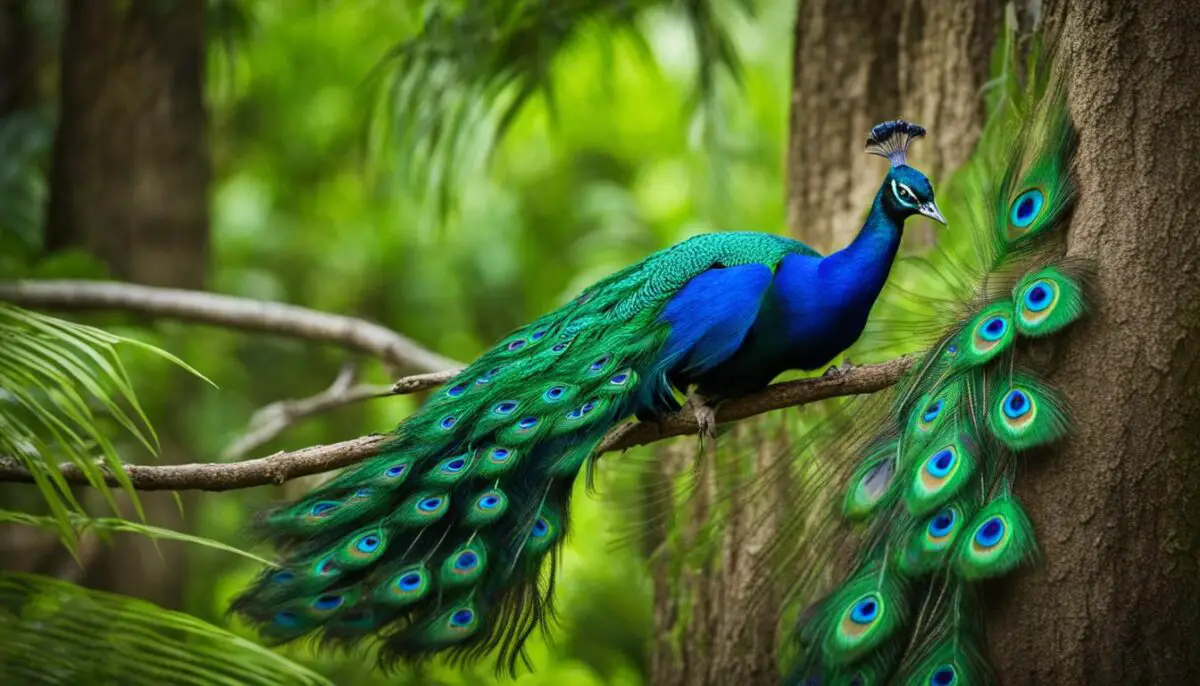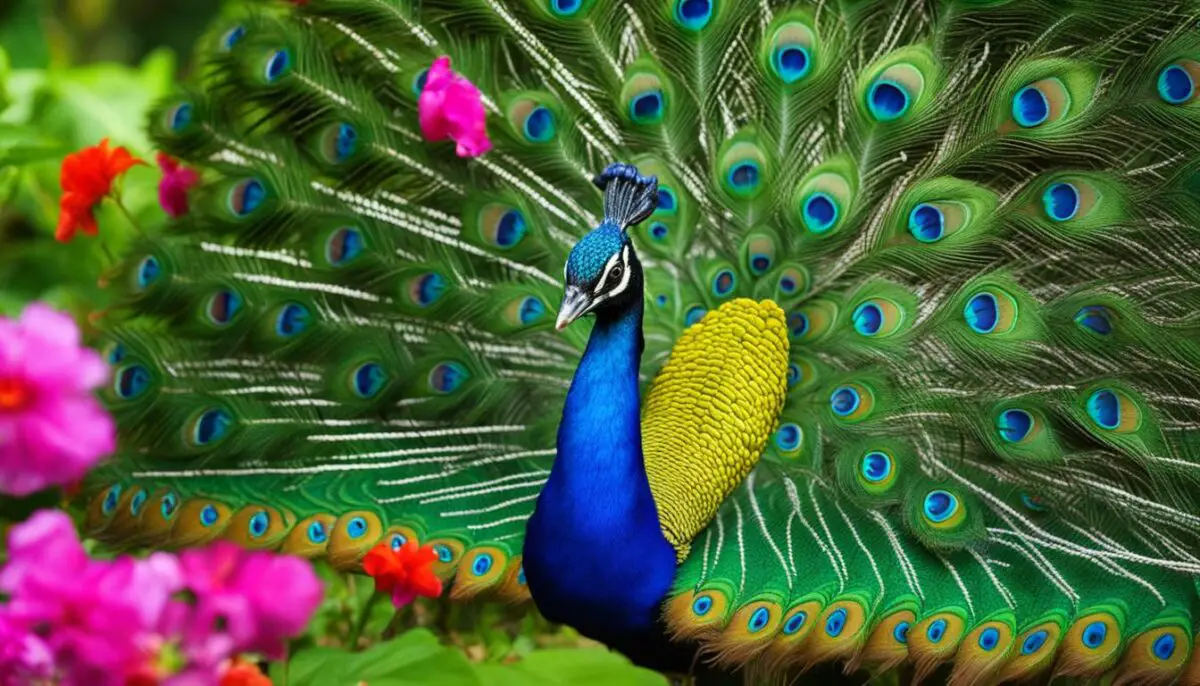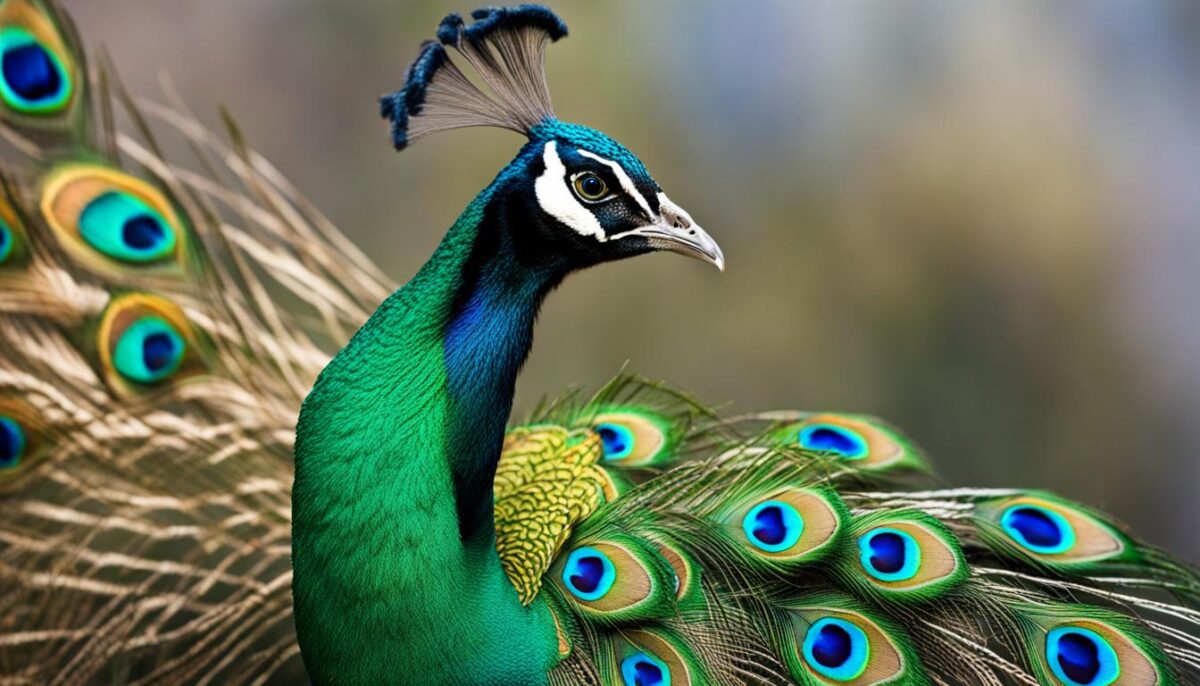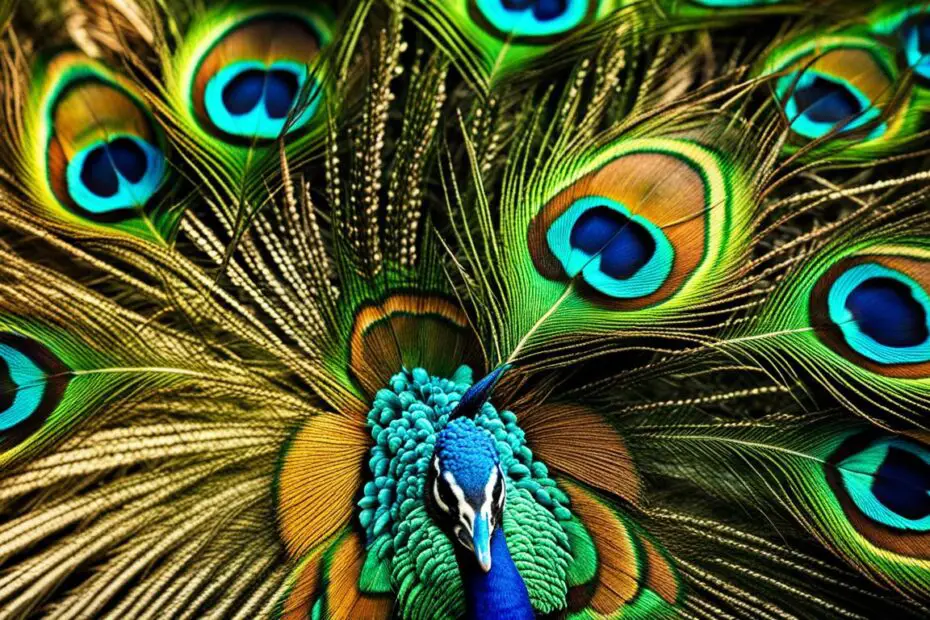Baby male peacocks, also known as peacock chicks, are breathtakingly beautiful creatures that captivate with their vibrant colors and enchanting behaviors. These miniature showstoppers are a wonder of nature, and exploring their characteristics and care requirements can deepen our understanding and appreciation for these fascinating birds.
Key Takeaways:
- Baby male peacocks are known for their stunningly vibrant colors.
- They exhibit charming behaviors, including courtship displays.
- Proper nutrition is vital for their healthy growth and development.
- Raising baby male peacocks requires special attention and care.
- Baby peacock feathers undergo a fascinating transformation as they grow.
The Striking Colors of Baby Male Peacocks
Baby male peacocks are known for their stunningly vibrant colors. Their feathers display a beautiful array of iridescent blues, greens, and purples, which make them a true visual spectacle. These radiant colors are not simply for show, but play important roles in attracting mates and establishing dominance within the peacock community. It’s truly a sight to behold!
As baby peacocks develop, their feathers undergo a remarkable transformation. Initially, they have a fluffy down-like appearance that gradually gives way to the vibrant plumes that peacocks are famous for. The colors of their feathers are not fixed, but change depending on the angle of light and the viewing position. This optical effect, called iridescence, creates a mesmerizing display as the feathers shimmer and change colors with each movement. It’s no wonder that baby male peacocks are often described as nature’s living works of art.
| Feather Color | Meaning |
|---|---|
| Blue | Symbolizes spirituality and protection |
| Green | Represents renewal, growth, and fertility |
| Purple | Signifies royalty, luxury, and power |
The vibrant colors of baby male peacocks not only serve as a visual spectacle but also have practical purposes. These colors play a crucial role in attracting females during courtship displays. Peacocks use their extravagant plumage to create an eye-catching fan, which they unfurl and shake while performing intricate dances to impress potential mates. The more vibrant and symmetrical their feathers, the more likely they are to catch the attention of female peahens. These displays are a captivating sight, showcasing the beauty and elegance of these enchanting birds.
Charming Behaviors of Baby Male Peacocks
Baby male peacocks are not only visually stunning but also possess charming behaviors that add to their allure. From an early age, these little showstoppers showcase their potential as magnificent adults through their unique courtship displays. One such behavior is the mesmerizing “train shaking” dance, where they fan their vibrant tail feathers and perform intricate movements to attract attention.
These courtship displays not only demonstrate their potential as future showstoppers but also provide insights into their social and mating dynamics. By observing their behavior, we can gain a deeper understanding of their intricate communication methods and the role these behaviors play in establishing dominance within the peacock community.
These courtship displays not only demonstrate their potential as future showstoppers but also provide insights into their social and mating dynamics.
In addition to courtship displays, baby male peacocks engage in other captivating behaviors. They are highly social creatures and often form close bonds with their flock mates, exhibiting playful interactions and communal activities. These charming behaviors not only showcase their affable nature but also highlight their intelligence and adaptability.
Understanding Baby Male Peacock Behaviors
To better understand the charming behaviors of baby male peacocks, let’s take a closer look at their courtship displays and social interactions:
| Behavior | Description |
|---|---|
| Courtship Displays | Male peacocks shake their vibrant tail feathers and perform a dance to attract mates and establish dominance. |
| Social Interactions | Peacocks form close bonds with their flock mates, engaging in playful interactions and communal activities. |
| Intelligent Adaptability | Peacocks exhibit intelligence and adaptability in their behaviors, showcasing their ability to thrive in various environments. |
These behaviors not only add to the charm and allure of baby male peacocks but also provide a glimpse into their intricate social and mating dynamics. Understanding and appreciating their captivating behaviors enhances our admiration for these magnificent creatures.
Understanding Baby Male Peacock Diet
Baby male peacocks require a well-balanced diet to support their vibrant feather growth and overall health. Providing them with the right nutrients is crucial for their development and longevity. Here is a breakdown of their dietary needs:
Dietary Components
A baby male peacock’s diet should consist of a high-quality bird feed that is specifically formulated for their nutritional requirements. This feed should be rich in protein, vitamins, and minerals to support their growth. Supplementing their diet with fresh fruits and vegetables is also important, as it provides additional vitamins and antioxidants.
Feather Growth
Feathers are a defining characteristic of peacocks, and their vibrant colors are a result of a healthy diet. Baby male peacocks need a diet that is rich in protein to support the growth of these colorful feathers. Protein sources such as insects, worms, and small fish are beneficial for their overall feather development.
Hydration
Keeping baby male peacocks hydrated is essential for their well-being. They should have access to clean and fresh water at all times. Providing a shallow dish or container for them to drink from and bathe in will ensure they stay properly hydrated and maintain the health of their feathers.
Supplementation
In addition to their staple diet, baby male peacocks may benefit from occasional supplementation. Calcium supplements can be provided to support healthy bone development, while probiotics can help maintain their digestive health. However, it is important to consult with a veterinarian experienced in avian care before introducing any supplements.
| Dietary Component | Sources |
|---|---|
| Protein | Insects, worms, small fish |
| Fruits and Vegetables | Fresh produce such as berries, leafy greens, and carrots |
| Water | Clean and fresh water in a shallow dish or container |
| Supplements | Calcium supplements, probiotics (consult a veterinarian) |
By providing baby male peacocks with a nutritious and varied diet, their feathers will grow vibrantly, and they will thrive both physically and mentally. Ensuring they have access to the right nutrients and a balanced diet will contribute to their overall well-being and enhance their natural beauty.
Raising and Caring for Baby Male Peacocks
Raising and caring for baby male peacocks requires special attention and dedication. These magnificent birds require a safe and spacious environment that mimics their natural habitat. Providing them with the right nutrition, socialization, and veterinary care is essential for their health and well-being.

Creating the Perfect Enclosure
When setting up an enclosure for baby male peacocks, it’s important to consider their space requirements. These birds need sufficient room to stretch their wings and move around comfortably. The enclosure should also be secure, protecting them from predators and providing them with a safe environment.
Adding features like perching structures, trees, and shrubs can provide enrichment and mimic their natural surroundings. It’s important to ensure the enclosure has proper heating and lighting to maintain optimal temperatures throughout the year.
Nutrition and Feeding
Proper nutrition is crucial for the healthy growth and development of baby male peacocks. Their diet should include a balanced mix of high-quality bird feed, supplemented with fresh fruits and vegetables. Ensuring they have access to clean, freshwater at all times is also essential.
Feeding them a varied diet not only provides the necessary nutrients but also helps stimulate foraging behaviors. Additionally, it’s important to monitor their food intake and adjust the portions as they grow to prevent overfeeding or malnourishment.
Socialization and Veterinary Care
Baby male peacocks are social creatures and benefit from interaction with their caretakers. Spending time with them, talking to them, and providing stimulation can help build a bond and create a positive environment for their mental well-being.
Regular veterinary check-ups are essential to monitor their health and detect any potential issues early on. Vaccinations, parasite prevention, and routine examinations are crucial to ensure they lead long, healthy lives.
| Key Points | Considerations |
|---|---|
| Enclosure | Safe, spacious, and includes perching structures |
| Nutrition | Balanced diet with bird feed, fruits, and vegetables |
| Socialization | Interaction and stimulation for mental well-being |
| Veterinary Care | Regular check-ups, vaccinations, and preventive care |
Raising and caring for baby male peacocks is a rewarding experience. By providing them with a suitable environment, proper nutrition, socialization, and veterinary care, you can ensure they thrive and continue to captivate with their vibrant colors and charming behaviors.
The Fascinating World of Baby Peacock Feathers
Baby peacock feathers are a marvel of nature, gradually transforming from fluffy down-like structures into the iconic iridescent plumes that peacocks are known for. These stunning feathers are a result of intricate biological processes that highlight the genetic makeup of these majestic birds.
As baby male peacocks grow, their feathers undergo a remarkable journey of development. Initially, their feathers appear soft and fluffy, providing insulation and protection. But as they mature, specialized cells called melanocytes produce pigments that give the feathers their vibrant colors. The unique structure of the feathers, with microscopic structures called barbules, further enhances the iridescence, causing the colors to shimmer and change depending on the angle of light.
“The transformation of baby peacock feathers into their vibrant, iridescent plumes is a captivating sight,” says Dr. Jane Wilson, an ornithologist specializing in peacock biology. “It’s a complex process influenced by genetic factors, hormones, and environmental conditions.”
The coloration of baby peacock feathers serves multiple purposes. It helps male peacocks attract mates during courtship displays, where they fan their tails in a magnificent display. The vibrant hues also play a role in establishing dominance within the peacock community, as males with more vibrant feathers are often considered more desirable by both females and other males.
The Biology of Peacock Feathers
Peacock feathers consist of two distinct types of feathers: covert feathers and train feathers. The covert feathers, found on the upper wings and back, have a more muted coloration and provide camouflage in the natural environment. In contrast, the train feathers, located on the tail, exhibit the vibrant colors that peacocks are famous for.
The train feathers are not only visually striking but also serve as a means of communication. When a male peacock fans out his train feathers in a courtship display, it creates a mesmerizing visual spectacle that captivates potential mates and rivals alike.
The evolution of these elaborate feathers is an evolutionary marvel. The intricate structure and vibrant colors have evolved over time to maximize the peacock’s chances of survival and reproductive success. These feathers not only showcase the beauty of the peacock but also highlight the wonders of nature’s design.
Table: Evolution of Baby Peacock Feathers
| Feather Type | Function | Evolutionary Adaptation |
|---|---|---|
| Covert Feathers | Camouflage | Muted coloration provides protection from predators |
| Train Feathers | Courtship display | Vibrant colors and iridescence attract mates and establish dominance |
- Baby peacock feathers start as soft and fluffy structures.
- Specialized cells called melanocytes produce pigments for vibrant colors.
- The unique structure of barbules enhances iridescence and shimmering effects.
- The vibrant colors attract mates and establish dominance within the peacock community.
The journey of baby peacock feathers from fluffy down to magnificent plumes showcases the complexity and beauty of nature’s design. Understanding the biology and evolution of these feathers deepens our appreciation for the remarkable world of baby male peacocks.
Fun Facts About Baby Male Peacocks
While baby male peacocks are truly mesmerizing creatures, there are some fascinating facts about them that may surprise you. These little showstoppers possess unique characteristics and behaviors that set them apart from other birds.
1. Feather Development: Did you know that baby male peacocks start growing their vibrant feathers as early as six months old? These feathers gradually transform into the iconic iridescent plumes that peacocks are known for. Each feather has a distinct pattern, similar to a fingerprint, making it truly one-of-a-kind.
2. Courtship Displays: Even at a young age, baby male peacocks demonstrate their potential as captivating showstoppers through their courtship displays. They practice their “train shaking” dance, fanning their vibrant tail feathers to attract attention. These charming behaviors provide a glimpse into their future role as magnificent spectacle-makers.
3. Social Dynamics: Baby male peacocks are not just beautiful; they also have a complex social structure. As they grow, they establish a pecking order within their community, with dominant males displaying their vibrant plumage to assert their authority and attract mates. This hierarchy ensures the balance and harmony of the peacock society.
| Fun Fact | Description |
|---|---|
| Feather Development | Baby male peacocks start growing their vibrant feathers as early as six months old, with each feather having a unique pattern. |
| Courtship Displays | Even at a young age, baby male peacocks practice their courtship displays, fanning their vibrant tail feathers to attract attention. |
| Social Dynamics | As they grow, baby male peacocks establish a pecking order within their community, with dominant males displaying their vibrant plumage. |
These are just a few fascinating facts about baby male peacocks. Their vibrant colors, charming behaviors, and unique social dynamics make them truly captivating creatures.
Vibrant Feathers and Charming Personalities
As baby male peacocks grow, their feathers become more vibrant and eye-catching. These feathers play a crucial role in attracting mates and establishing dominance within the peacock community. The unique patterns and colors of their plumage make them stand out in any setting, whether in the wild or as pets.
Aside from their stunning appearance, baby male peacocks also possess charming personalities. From a young age, they practice their courtship displays, captivating onlookers with their dances and tail feather displays. These behaviors not only showcase their potential as showstoppers but also provide insights into their social dynamics and pecking order.
Observing the development of baby male peacocks’ feathers and the growth of their personalities is a truly enchanting experience. Their fascinating journey from fluffy down-like structures to vibrant and unique plumes is a testament to the intricate biology and genetic makeup of these magnificent birds.
The Natural Wonder of Baby Male Peacocks
Baby male peacocks are nature’s little showstoppers, captivating us with their vibrant colors and enchanting behaviors. Whether admired for their stunning feathers or cherished as pets, these fascinating creatures continue to amaze us with their unique characteristics and roles within the ecological balance. Understanding their needs, care requirements, and the wonder they bring to the world deepens our appreciation for the beauty and intricate design of nature.
Where to Find Baby Peacocks for Sale
If you’re interested in owning a baby peacock, there are various sources where you can find them for sale. Reputable breeders, aviculture societies, and online marketplaces dedicated to exotic birds are some of the places to start your search. However, it’s important to ensure that you choose a reliable and ethical seller who can provide proper documentation and health guarantees for the birds.
When looking for baby peacocks for sale, consider reaching out to local aviculture societies or bird clubs. These organizations often have connections to reputable breeders who specialize in peacocks. They can guide you in finding a healthy and well-cared-for bird that meets your preferences.
Online marketplaces can also be a convenient option for finding baby peacocks. Websites dedicated to exotic birds often have listings from breeders across the country. Take the time to research and read reviews about the sellers to ensure their credibility and the well-being of the birds they offer for sale.

Table: Comparison of Baby Peacock Sellers
| Seller | Location | Reviews | Additional Information |
|---|---|---|---|
| Beautiful Birds Breeding | California | ★★★★★ | Specializes in rare peacock breeds |
| Feathered Friends | Texas | ★★★★☆ | Offers shipping services |
| Exotic Aviaries | Florida | ★★★☆☆ | Largest selection of peacock chicks |
When contacting a seller, ask about their breeding practices, the health history of the birds, and any specific care instructions. It’s essential to ensure that the birds have been properly cared for and are in good health before making a purchase. Additionally, request any necessary paperwork, such as health certificates or permits, to ensure compliance with legal requirements for owning peacocks in your area.
Remember, owning a baby peacock requires commitment and responsibility. Take the time to understand the care requirements and ensure that you can provide a suitable environment for the bird’s well-being. With proper research and careful selection, you can find a beautiful baby peacock that will bring joy and wonder to your life.
The Growing Popularity of Baby Male Peacocks as Pets
Baby male peacocks are captivating creatures that have been gaining popularity as exotic pets. These charming birds, with their vibrant colors and unique features, make for a truly distinctive companion. However, before considering a baby male peacock as a pet, it’s important to understand the care and commitment involved in raising them.
Raising baby peacocks requires special attention and care. Providing them with a safe and spacious enclosure is essential, as they need room to spread their stunning feathers and display their courtship behaviors. Baby male peacocks thrive in environments that mimic their natural habitat, so it’s important to ensure they have appropriate heating and lighting.
Just like any pet, baby male peacocks need proper socialization and enrichment activities to keep them mentally and physically stimulated. This can include perching structures, toys, and interactive playtime. Regular veterinary check-ups and vaccinations are also crucial to ensure their health and well-being.
It’s worth noting that baby male peacocks have a long lifespan, often living up to 20 years or more. This means that owning a baby peacock is a commitment that spans many years. Potential owners should carefully consider their ability to provide the necessary care, attention, and suitable environment for these magnificent birds before bringing them home.
| Pros of Owning a Baby Male Peacock | Cons of Owning a Baby Male Peacock |
|---|---|
| Unique and visually stunning pet | Requires a spacious enclosure |
| Charming behaviors and courtship displays | Long lifespan (up to 20 years or more) |
| Can serve as a conversation starter and display piece | Specialized care requirements |
| Adds a touch of elegance and beauty to any space | Commitment and responsibility involved |
Overall, owning a baby male peacock can be a rewarding and enchanting experience for those willing to devote the time, resources, and care required. These magnificent birds have a unique presence and bring a touch of nature’s beauty into our lives. However, it’s crucial to ensure that prospective owners are fully prepared for the commitment and responsibilities involved, ensuring a happy and healthy life for both the peacock and their human companions.
The Enchanting Presence of Baby Male Peacocks in Nature
As mesmerizing creatures, baby male peacocks, also known as peacock chicks, bring a touch of wonder to the natural world. Their vibrant colors and graceful movements make them a sight to behold. These enchanting birds play a crucial role in their ecosystem, contributing to seed dispersal, insect control, and pollination. Their striking presence and distinctive calls add to the overall beauty and diversity of nature.
In their native habitats, baby male peacocks roam freely, using their exquisite feathers to attract mates and establish dominance. Their radiant plumage not only dazzles the eye but also serves as a natural defense mechanism, intimidating potential threats and predators.

The Importance of Baby Male Peacocks
“Baby male peacocks play an essential role in maintaining the ecological balance. Their graceful movements and vibrant colors contribute to the overall beauty of their surroundings.”
– Wildlife Biologist
By foraging for food, baby male peacocks contribute to the dispersal of seeds, helping to promote the growth of various plant species. In their quest for insects, they aid in natural pest control, keeping populations in check. Additionally, as they move from flower to flower, baby male peacocks inadvertently facilitate pollination, ensuring the continued reproduction of many plants.
The Future of Baby Male Peacocks
“Understanding the importance of baby male peacocks in their natural habitat is crucial for their conservation. By protecting their ecosystems and preserving their habitats, we can ensure the survival of these magical creatures for generations to come.”
– Environmentalist
Unfortunately, baby male peacocks face numerous threats, including habitat loss, illegal hunting, and climate change. Conservation efforts and sustainable practices are essential to safeguarding these majestic birds and the delicate balance they maintain in the wild.
Preserving the Beauty
- Support wildlife conservation organizations
- Advocate for sustainable land and resource management
- Spread awareness about the importance of preserving natural habitats
- Refrain from supporting the illegal trade of peacocks or their feathers
The enchanting presence of baby male peacocks serves as a reminder of the intricate interconnectedness of the natural world. As we marvel at their beauty, let us also strive to protect and preserve their habitats, ensuring that future generations can continue to be captivated by the vibrant displays of these remarkable birds.
Conclusion
Baby male peacocks are nature’s little showstoppers, captivating us with their vibrant colors, charming behaviors, and unique features. Whether admired in their natural habitat or cherished as pets, these magnificent birds continue to fascinate and inspire awe.
Understanding their needs, care requirements, and the role they play in the ecosystem deepens our appreciation for the wonder and beauty of these enchanting creatures. Baby male peacocks are not just visually stunning, but they also contribute to the ecological balance by aiding in seed dispersal, insect control, and pollination.
By caring for baby male peacocks responsibly, we can ensure that their captivating presence continues to grace our lives and the natural world. So, whether you are an enthusiast or someone planning to bring home a peacock as a pet, remember to provide them with the love, care, and suitable environment they need to thrive.
FAQ
What colors do baby male peacocks have?
Baby male peacocks display vibrant iridescent blues, greens, and purples in their feathers.
What behaviors do baby male peacocks exhibit?
Baby male peacocks practice courtship displays, known as “train shaking,” where they fan their tail feathers and perform a dance to attract attention.
What should I feed baby male peacocks?
Baby male peacocks require a balanced diet of high-quality bird feed, supplemented with fresh fruits and vegetables.
How do I raise and care for baby male peacocks?
Baby male peacocks need a safe and spacious enclosure, appropriate heating and lighting, socialization, enrichment activities, regular veterinary check-ups, and vaccinations.
How do baby peacock feathers develop?
Baby peacock feathers start as fluffy down and gradually transform into the iconic iridescent plumes that peacocks are known for.
What are some interesting facts about baby male peacocks?
Baby male peacocks can start displaying their vibrant feathers as early as six months old, and each peacock feather has a unique pattern, like a fingerprint.
Where can I find baby peacocks for sale?
Reputable breeders, aviculture societies, and online marketplaces dedicated to exotic birds often have baby peacocks available for sale.
Why are baby male peacocks gaining popularity as pets?
Baby male peacocks are attractive choices for bird enthusiasts and those looking for a distinctive pet due to their unique beauty and charming personality.
What role do baby male peacocks play in the ecosystem?
Baby male peacocks contribute to seed dispersal, insect control, and pollination, and their presence adds to the diversity and beauty of nature.


